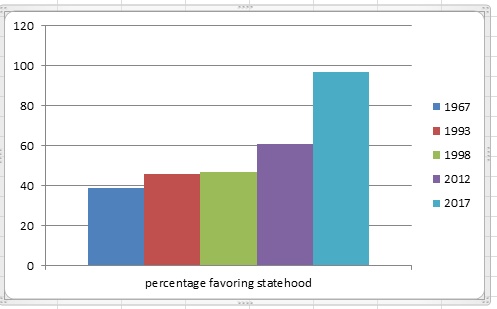Puerto Rico has held five plebiscites, local votes on the residents’ preferred political status. The percentage favoring statehood has increased each time, culminating in 2017 in a 97% majority.

Now some political leaders are calling for another vote. Statehood supporters do not object. We are confident that the new vote will show the same results as previous referenda: statehood is the most popular option.
Statehood opponents have objected to previous plebiscites, going so far as to boycott the 2017 vote.
Nobody boycotts a vote they can win. Click To TweetWhat are the options?
There are three viable options for Puerto Rico:
- statehood
- independence
- territory
We know what statehood would be like: there are already 50 states. 32 of the states were territories before they became states, and all have become safer and more prosperous as states. New states have the same rights and responsibilities, by law, as other states.
We know what independence and Free Association would look like, too. Cuba and the Philippines joined the United States at the same time as Puerto Rico. Both chose independence and are independent nations. Palau and the Marshall Islands are independent nations in Free Association with the United States. None of these nations has U.S. citizenship.
We also know what being a territory is like. Territories do not have the same rights and responsibilities as states. As a territory, Puerto Rico receives much less federal support than it would as a state. It has no sovereignty and a limited voice in U.S. democracy.
But the “commonwealth” party, which is increasingly split between the fantasy of “enhanced commonwealth” and the sovereignty of an imagined Compact of Free Association, continues to claim that Puerto Rico has another option. They can’t agree on what they want that option to look like, let alone what it would actually look like.
The example of Brexit
So where can we get an idea about what “Enhanced Commonwealth” might look? Have a look at Brexit.
In 2016, in a non-binding referendum like the Puerto Rico plebiscites, the voters of Great Britain voted to leave the European Union. As members of the EU, they had the right to travel freely and work in any EU country, an open market, a shared currency, and a shared charter of rights.
On the other hand, they also had to follow EU policies, to allow people from all EU countries to travel and work freely in the UK, and to take part in a single market with a single currency. The Brexit supporters gave Britons a vision of a deal in which they could keep the single market and single currency without having to follow the EU’s rules. They would be able to make their own awesome trade deals. In fact, the Brexit propaganda sounded a lot like the commonwealther’s Fantasy Island deal with the U.S. With a tiny majority, the Leavers beat the Remainers in 2016.
Since then, they have been trying to negotiate a deal with EU which will let Britain keep the benefits of EU membership as they leave the EU. It isn’t working. “The BREXIT reality of 2019 bears no resemblance to the Brexit fantasy promised in the 2016 referendum,” wrote Hugo Dixon in The Economist. “In the real world, you cannot have your cake and eat it. You need to make trade-offs.”
The EU has no reason to give Britain its special deal, and they won’t. The U.S. also has no reason to give Puerto Rico its special deal, and all three branches of the government have repeatedly said that they won’t. The UK currently has a deal that will make them follow EU rules without having any input into those rules, which doesn’t allow them to make trade deals without following EU trade rules, and which will lose them a lot of money. So far, they’re refusing to agree to that deal.
In March, they will have to choose between accepting that deal and leaving the EU with no deal at all. Some in the UK are trying to undo Brexit, calling for another vote (which might be impossible, since the EU would have to agree to any delays), or just refusing to leave.
Those calling for another Brexit referendum might be in the position of Puerto Rico, where many leaders are determined to keep holding votes till they get the answer they want. That’s not how democracy works.
Choosing a status option
If Puerto Rico holds another referendum, voters must understand what they’re voting for. Choosing the territory option means choosing to keep Puerto Rico as it is. The “commonwealth” party may pretend that they’ll negotiate something special, but the federal government has made it clear that a territory is a territory.
Choosing independence means independence, very possibly with no deal, just like Brexit. Will it be possible for Puerto Rico to vote for independence, discover that they can’t get a special deal, and then back out? The UK got a court decision allowing them to change their minds, but Puerto Rico can’t assume they’ll get the same results. They could, like the UK, end up on the outside with no deal at all.
Choosing statehood is straightforward. We can see what it’s like to be a state. We don’t have to guess, or to rely on fantasy. Tell your congressperson that you want statehood for Puerto Rico. The time is now.








No responses yet